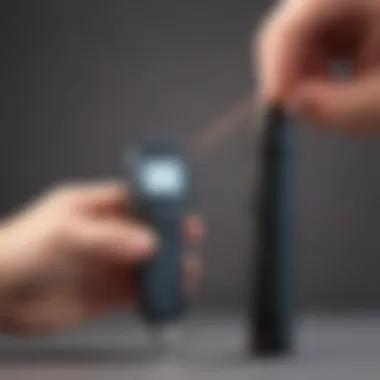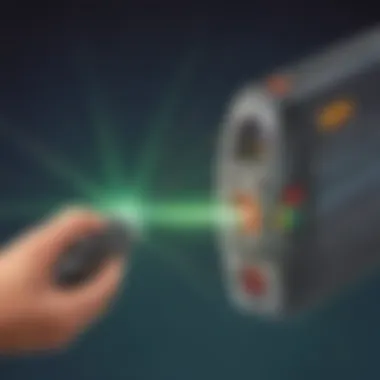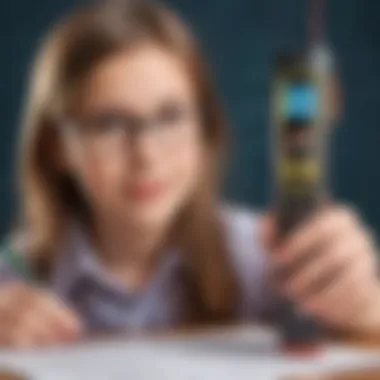Understanding Laser Pointer Measurers for Young Scientists


Intro
Laser pointer measurers are essential tools in today's scientific landscape. They represent a blend of precision and fun in measurement. Understanding how these devices work allows young science enthusiasts to explore the world of measurement and technology more deeply.
The aim of this guide is to shed light on the principles behind laser measurers, share their practical uses, and emphasize the importance of safety when using them. With engaging insights and accessible language, this article seeks to spark curiosity in young learners, helping them take their first steps in scientific exploration.
Science Fun Facts
Interesting Trivia and Facts
Laser pointers may seem simple, but they have fascinating facts:
- The first laser was built in 1960 by Theodore Maiman. It used a ruby crystal.
- Laser light is monochromatic, meaning it contains one color of light, unlike normal light.
- The term
Preamble to Laser Pointer Measurers
Laser pointer measurers have revolutionized the understanding and application of distance measurement. These devices use light to achieve remarkable accuracy, saving time and effort in various tasks. It’s crucial for young science enthusiasts to appreciate what these measurers do and why they matter. This introduction lays the groundwork for understanding their function, bridging the gap between theory and hands-on experience.
Definition and Purpose
Laser pointer measurers, commonly known as laser distance meters, are instruments that utilizes a laser beam to measure distances accurately. The basic working principle involves emitting a laser light that reflects off an object, returning to the device. The time taken for the light to return is calculated and converted to distance, allowing for precise measurements.
The primary purpose of these devices includes:
- Accuracy: They are capable of measuring both short and long distances with very low margin of error.
- Ease of use: Most models are user-friendly, making them suitable for a varied audience including kids, DIY enthusiasts, and professionals.
- Versatility: These tools can be used indoors and outdoors for different applications ranging from simple room measurements to complex surveying tasks.
History of Laser Technology
The inception of laser technology comes from a journey rooted in scientific exploration. The word “laser” stands for Light Amplification by Stimulated Emission of Radiation. This concept emerged from numerous discoveries in the field of physics. The first laser was developed in 1960 by Theodore H. Maiman, who used ruby crystals.
Over the decades, pinnacles in technology led to the development of various types of lasers. These advancements laid the groundwork for serene applications like laser pointer measurers. The integration of laser systems into measurement tools occurred as repercussions of laser growth. By the late 20th century, the inception of include compact and sophisticated reproducible laser pointer meassuers began, available for broader public use.
Understanding this historical context enhances our appreciation of current technologies. The transition from large machinery to hand-held devices shows remarkable progression in engineering and its implications for scientific measurement.
How Laser Pointer Measurers Work
Understanding the operation of laser pointer measurers is essential for grasping their role in scientific exploration and practical use. This section delves into the crucial elements of measuring light distance and its applications. With the increasing use of these devices, comprehension of how they function helps aspiring young scientists utilize them effectively.
Basic Principles of Measurement
Laser pointer measurers operate on the simple yet effective principle of triangulation. The device emits a laser beam, which travels to a target surface and reflects back to a sensor in the device. The time taken for this round trip is measured accurately by advanced electronic components. This duration is then converted into a distance measurement via a straightforward calculation based on the speed of light.
The formula here is a key aspect. Understanding its significance promotes deeper insights.
For example, the formula is: Distance = (Time x Speed of Light) / 2.
This core principle—capturing the reflection time of a laser beam—allows for precise determination of distance. The accuracy typically ranges within a small fraction of centimeter. As young learners comprehend this, they build a solid foundation in measurement techniques that are pivotal in various scientific disciplines.
Additionally, understanding this principle encourages curiosity and experimentation with real or hypothetical measurement scenarios, making science more hands-on.


Components of a Laser Measurer
A laser measurer is not just a simple tool; it is composed of several integral components that work together seamlessly. Key components include:
- Laser Emitting Device: It sends out the laser beam.
- Receiver: This captures the reflection of the emitted beam.
- Calculator: Often built-in, this processes the time data and computes the distance.
- Display Screen: Shows real-time measurements for user reference.
- Body: Usually robust and made for handling, helping provide better usability.
Each component plays a crucial role to ensure accuracy. For young enthusiasts, the goal is not just to see the tool as a measuring device, but also to recognize it as a scientific instrument. Understanding every part deepens their knowledge about technology and encourages an analytical approach towards gadgets they encounter in daily life.
Applications of Laser Pointer Measurers
Laser pointer measurers have profound significance in various fields. These devices not only simplify measurement processes, but also add an element of efficiency and precision to tasks that require careful calculations. Understanding their applications provides clarity on why they are hailed as vital tools for professionals and young scientists alike.
Use in Construction and Architecture
In construction and architecture, laser pointer measurers play a pivotal role. They are fundamental in ensuring accuracy during the measuring phase of building projects. Traditional measuring tapes can introduce errors, especially when trying to determine distances over large areas or heights. A laser measurer eliminates most of these concerns.
Benefits include:
- Precision: Laser measurers provide highly accurate distance measurements.
- Efficiency: They can quickly measure large distances where manual tools may falter, helping professionals save time.
Construction works often benefit from computer-aided designs where spatial dimensions are important. Quick adjustments based on real-time measurements can vastly enhance project performance. Increased speed and accuracy contribute to keeping projects on schedule and within budget.
Role in Surveying and Land Measurement
The surveying field significantly utilizes laser pointer measurers for land and property assessments. In this discipline, accurate measurements are crucial. Surveyors often deal with complex terrains, and traditional methods can be both time-consuming and error-prone.
In land measurement, laser devices help:
- Record levels: Determining the elevation of a given point is streamlined.
- Create plots: Land plots can be analyzed and measured much more efficiently, providing essential data for legal and development purposes.
Surveyors can obtain measurements quickly and ensure precision during important assessments. Furthermore, laser measurements assist in documenting changes over time for geological surveys or environmental assessments.
Applications in Science Experiments
For young science enthusiasts, laser measurers are engaging tools for hands-on learning. Many school science experiments can incorporate distance measuring in physics projects. By allowing students to track and measure distances accurately, these devices foster a sense of scientific inquiry.
Applications might include:
- Collecting data: Students can experiment with light propagation and speed when measuring precise distances.
- Testing ideas: Recognizing concepts such as angles in relation to surfaces or determining heights of specific objects can become interactive.
The understanding derived from using laser measurers amplifies practical experience, encouraging curiosity in exploring scientific principles. This purposeful use of technology supports educational goals and cultivates future interest in science among young learners.
Knowing how to effectively measure with laser devices shapes accuracy and scientific reliability. Encouraging interactions with this technology is a step towards fostering innovation.
Benefits of Using Laser Pointer Measurers
Using laser pointer measurers offers multiple advantages, especially for young science enthusiasts who seek to understand measurements in both simple and complex environments. These tools enhance learning and experimentation while laying a solid groundwork in measurement principles. Young learners gain a clear sense of measurements in real-world applications, building a strong connection between theory and practice.
Accuracy in Measurement
Laser pointer measurers are notable for their high accuracy compared to traditional tape measures or rulers. The reason for this accuracy lies in the way the laser technology functions. When a laser beam is emitted from a device, it travels in a straight line to the object being measured. It then reflects back to the measurer, allowing the device to calculate the distance with impressive precision.


One critical aspect to consider here is the margin of error. Compact laser measurers often provide results with an accuracy range of just a few millimeters, making them ideal for both scientific experiments and simple home uses, like measuring a room for painting or decorating. The reduced chances of human error in comparison to manual methods cannot be emphasized enough. For students learning the importance of exact data, this feature proves significant in establishing reliable results.
- Enhanced Problem-Solving: High accuracy aids in generating more relevant data; children can analyze and question observed measurements.
- Confidence in Learning: Knowing the results are precise boosts young learners’ confidence, on aiding their overall appreciation for scientific methods.
Efficiency and Time-Saving
In addition to accuracy, efficiency is a vital element of laser pointer measurers that resonates well with young users eager to examine their experiments within defined timeframes. The immediate results from a laser measurement encourage quick feedback during educational explorations.
Unlike traditional methods, which require measuring, marking, and retrial until conformity is achieved, laser measurers provide instantaneous results. This practcial enhancement allows children to divert their attention and energy towards understanding results rather than getting bogged down with the technique of measuring.
- Fewer Steps to Achieve Outcomes: Students can save on unnecessary time that they might spend with costly and lengthy measuring methods.
- More Time for Exploration: With lighting-fast outputs, learners can immerse themselves in additional experimentation or delve into the ‘what ifs’ that spark curiosity.
Laser pointer measurers catalyze interest by balancing rigorous results with an approachable and engaging learning avenue.
In sum, both accuracy and efficiency make laser pointer measurers invaluable tools for young science enthusiasts. Not only do they enhance the accuracy of measurements, but they also foster an environment ripe for exploration and hands-on learning. By improving reliability and minimizing outdated methods, young learners can cultivate their budding interests in science while benefiting from cutting-edge technology.
Safety Considerations
Ensuring safety when using laser pointer measurers is essential, especially for young science enthusiasts. With their potential to cause eye injury if misused, it's crucial to understand hazard factors related to laser technologies. Certain regulations categorize lasers, warning users about how to handle them properly. Awareness in safety strategies allows for structured, productive experimentation, encouraging curiosity while minimizing risk.
Understanding Laser Classifications
Lasers are classified based on their potential danger. Categorization ranges from Class 1 to Class 4, with increasing risk. Here's a brief overview:
- Class 1: These lasers are safe under normal operation. Even direct exposure poses no harm to the eyes. Examples are laser printers and CD players.
- Class 2: This category includes visible lasers. They can cause damage when stared at for an extended period, as the blink reflex cannot protect against exposure.
- Class 3: Class 3 lasers can cause eye damage and, depending on their beam features, can also cause skin burns. Awareness is key when working with these devices.
- Class 4: These are high-risk lasers, often used in research and industrial settings. Not only can they harm the eyes instantly, they also pose fire hazards and skin burns.
The classification of lasers is essential information for safe use. Knowing a laser's class helps determine appropriate handling precautions and protective measures.
Understanding which class of laser is being used sets a clear expectation on safety behavior. Children should be under adult supervision when using any lasers, starting mainly with Class 1 for intro experiments can create a safe learning environment.
Safe Usage Guidelines for Children
While exploring science can be exciting, safety should come first. Here are some important guidelines for using laser pointer measurers:
- Always Use with Adult Supervision: Children should never operate laser measurers without an adult present. Guidance helps avoid accidental misuse or dangerous situations.
- Point Away from Eyes: Teach children to not point lasers at anyone's face or into the sky. Only aim at surfaces where no one is standing.
- Avoid Reflective Surfaces: Engaging with reflective items can bounce the laser beam unexpectedly, increasing potential hazards.
- Read Manufacturer’s Instructions: Each laser has unique guidelines. Instruct children to listen carefully to the instructions provided to understand correct usage.
- Turn Off When Not in Use: It's good practice to turn off the laser when the measuring process is done to avoid accidental activation when it's not needed.
Ensuring safy while using a pointer laser measurer will facilitat positive science experiences, allowing young learners to engage multiple aspects of experimentation with confidence in a protective atmosphere.
Hands-On Activity: Measuring with a Laser Pointer
Engaging in hands-on activities is a crucial aspect of learning, especially in science education. This particular hands-on activity allows young science enthusiasts to apply their theoretical knowledge about laser pointer measurers in practical captures. By measuring things in their surroundings, children will develop a better understanding of distance measurement as well as enhance their work precision skills. Moreover, the experiential learning aspect helps foster curiosity and innovative thinking.
Materials Needed
Before delving into the activity, ensure that you have the following materials:
- A laser pointer or laser distance measurer
- A measuring tape
- Paper
- Pencil
- Object(s) to measure, such as a desk or a room (ideal for a starting point)
- Safety glasses (optional but recommended for safety)
These components are all easily accessible and promote periodic reflections upon what the children are learning as they proceed through each step of the activity.
Step-by-Step Instructions


Follow these steps cautiously to conduct the measuring activity effectively:
- Choose an Object to Measure: Decide on an object to measure. Preferably, select something with clear dimensions. This could be a piece of furniture, or the wall across the room.
- Set Up Your Laser Pointer: Ensure the laser pointer or laser measurer is fully charged or has fresh batteries. Aim the pointer at one edge of the object and note its position on paper.
- Measure: Point the laser directly to the opposite edge of the object you want to measure. Depending on your device, check the reading. If using just a laser pointer, use the tape measure to confirm the distance.
- Record the Measurement: Write down the measurement on your paper. It’s helpful to log multiple measurements from various distances if you're inclined.
- Repeat with Various Angles: For better understanding, repeat the measurement from different angles. This also shows how laser technology gives consistent data irrespective of where you stand.
- Draw Conclusions: After several measurements, look at your data and discuss the accuracy and reliability of the results you found.
This interactive process elevates understanding of basic scientific principles. By encouraging kids to be observers and record-keepers, it induces dedication to detail and nurtures their analytical skills.
In summary, this hands-on activity exemplifies the practical applications of laser pointer measurers, making it not just informative, but also fun and relevant to young learners.
Future Advancements in Laser Measurement Technology
Understanding future advancements in laser measurement technology is vital for recognizing how these tools might evolve and impact various fields, particularly for science enthusiasts. As technology progresses, so do the functionalities and capabilities of laser pointer measurers. These advancements offer enhanced performance, more features, and increased accessibility to learners at a young age.
Trends in Scientific Research
In recent years, research has focused on making laser measurement technology more precise and user-friendly. Innovations are constantly emerging that cater to specific needs in experiments and practical applications:
- Integration with smartphones: Many new laser measurers can connect to mobile devices, allowing users to see measurements in real time.
- Increased measurement range: Advances have been made to extend the maximum distance that a laser can accurately measure. This allows for effortless long-distance measurements in various settings, from classrooms to construction sites.
- Automation features: Some laser instruments are now incorporating automation. This allows for set measurements to be taken continuously, which can speed up scientific data collection significantly.
Over time, as technology becomes more accessible, young science enthusiasts will likely have access to these innovative tools. This makes science experiments more exciting and can enhance learning experiences significantly.
Innovative Applications on the Horizon
As advancements in laser measurement continue, new applications are developing that can benefit different fields:
- Environmental monitoring: Lasers can help scientists track changes in landscapes, weather patterns, and even wildlife populations. This can be essential for studies on climate change and conservation efforts.
- Healthcare: Lasers are making way for non-invasive measurement techniques in medical applications, supporting better diagnosis and treatment. For instance, laser technology is being used in optometry to measure the curvature of the eye.
- Education: Educational tools equipped with advanced laser technology can provide interactive learning experiences. They engage kids with hands-on activities in interesting ways.
These advancements not only improve existing methods but also open the door to entirely new scientific explorations. Young learners are at the forefront of these changes, using enhanced laser measurers in innovative experiments and projects.
"Technological evolution is continuously reshaping our understanding of measurement, making it more precise and broadening its applications across various scientific fields."
Overall, future advancements in laser measurement technology represent an exciting frontier for scientific inquiry, especially for young enthusiasts keen to explore the world around them.
Ending
The conclusion of this article is highly important, as it synthesizes the information provided about laser pointer measurers, their functionality, and their relevance for young science enthusiasts. Understanding the role of these innovative measuring tools is essential not just for academic purposes, but also for sparking curiosity and engaging with science in practical ways.
Here are the key aspects discussed:
- Summarization of Principles: Laser measuring devices operate based on specific principles that are crucial for obtaining accurate measurements.
- Diverse Applications: From construction to education, these tools serve multiple functions across a range of fields. This versatility underscores their significance, especially for young learners who may explore different scientific interests.
- Safety Practices: The article emphasizes the need for safety when using laser devices. Knowing how to handle these tools helps prevent accidents and fosters responsible exploration of technology.
In summary, recognizing the benefits of laser pointer measurers and incorporating them into learning enables students to engage more deeply with scientific concepts and activities. This understanding can serve as a stepping stone in their journey as budding scientists.
Recap of Key Takeaways
- Laser pointer measurers utilize laser technology for accurate measurements.
- They are widely used in fields like construction, surveying, and scientific experiments.
- Efficiency and precision are major benefits of utilizing these devices.
- Understanding laser classifications and usage guidelines is critical for safety.
Encouragement for further exploration:
- Young science enthusiasts should feel empowered to engage with technology and experiments around them.
- Always return to the fundamentals: curiosity and learning are paramount in science.
Encouraging Young Scientists
To foster the next generation of scientists, we must nurture curiosity and promote hands-on learning. Laser pointer measurers provide a unique platform for young minds to discover, measure, and experiment.
- Engage with laser measurement tools through interactive projects.
- Emphasize the importance of safety while experimenting.
- Encourage critical thinking by allowing children to ask questions and explore answers in real-world scenarios.
By actively encouraging and guiding youth in science, we can pave the way for innovative ideas and solutions in the future. These young scientists will develop skills that not only boost their academic journeys but also their personal growth.







